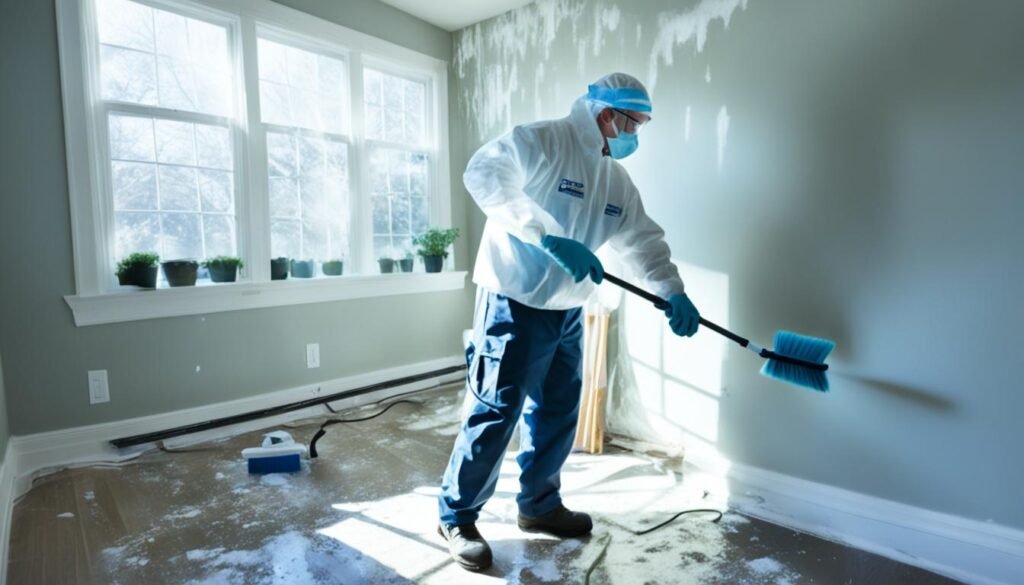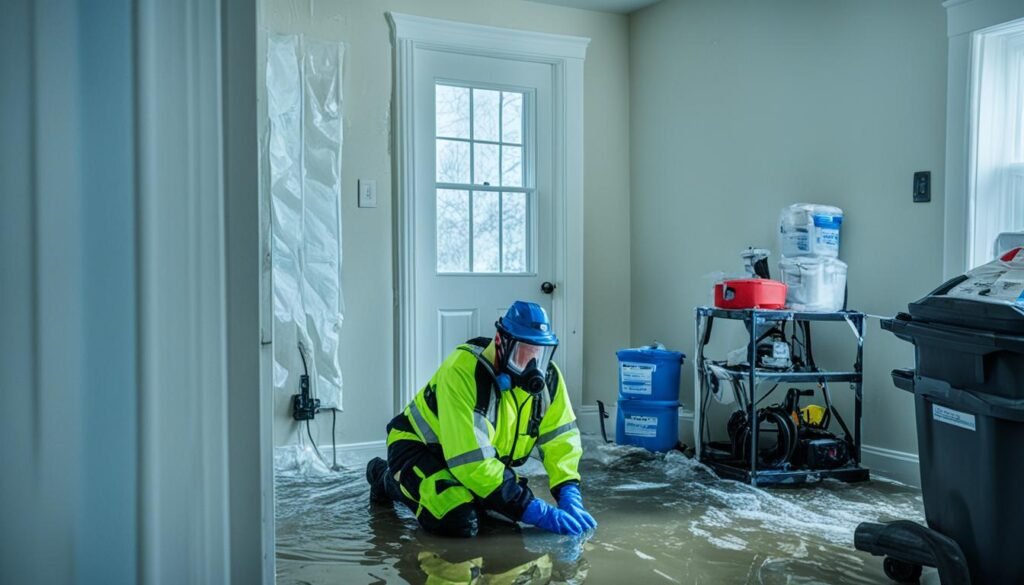Mold can start to grow in just 24 to 48 hours after water exposure. It will keep spreading if the area stays moist. To stop mold after a flood, it’s key to manage the moisture levels.
To protect your home, act fast to dry out the flood-affected areas. By following these tips, you can halt mold growth. You’ll also keep your home safe from health dangers.
Key Takeaways:
- Act quickly to dry the affected area after a flood to prevent mold growth.
- Open up the building to increase airflow and ventilation.
- Remove all debris and wet items, especially porous materials.
- Clean exposed surfaces with disinfectants or sanitizers.
- Utilize fans and dehumidifiers to circulate air and reduce moisture.
For full details on how to stop mold growth post-flood, check out our detailed guide below.
How to Prevent Mold After a Flood
To prevent mold after flooding, act fast to set up good prevention methods. Quick actions can lower the risk of mold and keep flooded spots safe.
- Open the building to increase airflow and ventilation. This helps moisture escape and stops mold-friendly air.
- Remove all debris and wet items, paying special attention to porous or absorbent materials. Mold grows easily in these.
- Clean exposed surfaces with disinfectants or sanitizers to kill any existing mold spores.
- For wet carpeting, use a carpet extractor or wet/dry vacuum to remove water. Make sure the carpet dries completely.
- Use fans to move air and speed up drying. But, don’t use fans if mold has started to grow, as they spread spores.
- Put dehumidifiers in closed areas to cut down moisture in the air. Keep humidity under 50% to stop mold from growing.
Keep dehumidifiers running until all porous surfaces are dry. This can take from a few days to weeks, based on water damage severity. Check moisture levels often and keep air moving.
It’s key to prevent mold in flood-hit areas to maintain a healthy living space. By using these methods, you can safeguard your home and family’s health.
| Mold Prevention Techniques | Effectiveness |
|---|---|
| Increased airflow and ventilation | Highly effective |
| Removal of debris and wet items | Essential |
| Cleaning exposed surfaces with disinfectants | Significantly reduces mold spores |
| Water removal from saturated carpeting | Prevents mold growth |
| Utilizing fans for air circulation | Effective if mold growth hasn’t started |
| Implementing dehumidifiers | Reduces moisture levels |
Mold Cleanup and Safety Precautions after a Flood
When dealing with mold cleanup after flooding, your safety is key. Take the right steps to avoid health risks. Here’s what you need to do:
- Wear proper gear like gloves, goggles, and an N-95 respirator. This protects you from mold spores and chemicals.
- Use effective cleaners for mold on hard surfaces. These can be mold removers, washing soda, or bleach mixed with water. They kill mold and stop it from coming back.
- If mold covers over 10 square feet or if there’s a lot of water damage, get professional help. Mold remediation professionals have the skills and tools for big cleanup jobs.
General Safety Precautions after a Flood
It’s crucial to follow more safety steps after a flood to stay safe:
- Get a pro to check and clean your HVAC. This stops mold from spreading in your air system.
- Watch out for signs of a mold problem like strange smells or warped materials. Act fast if you see these signs.
- Pay attention to your health for mold exposure symptoms like breathing issues, allergies, or skin and eye irritation. See a doctor if you have these symptoms.
Following these mold cleanup and safety measures helps you deal with flood effects safely. This way, you prevent mold problems.

| Mold Cleanup Tips | Safety Precautions |
|---|---|
| Wear protective equipment (gloves, goggles, respirator) | Have HVAC system checked and cleaned |
| Utilize effective mold cleaning products | Be aware of signs of a mold problem |
| Seek professional assistance for extensive mold growth | Monitor health for symptoms of mold exposure |
Conclusion
Stopping mold growth after a flood is key to keeping your home and health safe. You can protect your living space and stay healthy by using simple steps to stop mold.
To start, dry the flooded area fast. Throw away any wet items and debris. This stops mold from starting. Use the right cleaners on all surfaces to get rid of mold risks.
Good airflow and using dehumidifiers are vital. Open windows and doors to let air move freely. Dehumidifiers can lower moisture, which helps stop mold in closed spaces.
Wearing safety gear like gloves, goggles, and masks is important. It keeps you safe from mold spores. Always look for signs of mold, like a musty smell or damaged items. If you find mold, get help from pros.
With these steps, you can stop mold from growing after a flood. This keeps your home safe and healthy for your family.


